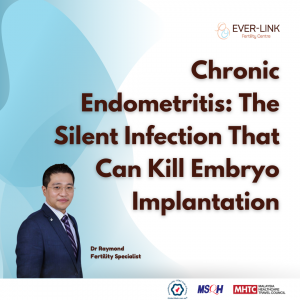
When couples face repeated IVF failures or unexplained infertility, doctors usually check the eggs, sperm, and uterus. But there’s one hidden problem that often goes unnoticed chronic endometritis. It’s not the same as a painful infection you can feel. Chronic endometritis is a quiet, low grade inflammation of the uterine lining. Many women don’t even know they have it, because they don’t have clear symptoms. Yet, research shows it can directly interfere with embryo implantation and treating it can dramatically improve pregnancy success.
What Is Chronic Endometritis?
Chronic endometritis happens when the cells lining the uterus (the endometrium) are persistently inflamed. Unlike an acute infection, it doesn’t always cause fever, pain, or heavy bleeding. Instead, the uterus becomes an unfriendly environment for embryos preventing them from attaching and growing.
Clinical Evidence:
A study by Cicinelli et al. (2015) in Reproductive Sciences found that chronic endometritis was present in up to 30% of women who had repeated implantation failure after IVF.
How Does Chronic Endometritis Affect Fertility?
The endometrium needs to be calm, thick, and receptive at the time of implantation. If inflammation is present:
- The uterine lining may not properly prepare for the
- The immune system may attack or reject the
- Hormonal signals needed for implantation may be
All of this reduces the chances of successful pregnancy, even if the embryo is genetically normal.
Symptoms: Why It Often Goes Unnoticed
Most women with chronic endometritis feel fine. Some might experience:
- Light spotting between periods
- Unusual vaginal discharge
- Mild pelvic discomfort
- Repeated miscarriages or failed IVF attempts
But often, there are no clear warning signs at all. That’s why it’s called a “silent” fertility blocker.
How Is It Diagnosed?
Chronic endometritis cannot be diagnosed with a regular ultrasound or blood test. The gold standard is:
- Endometrial biopsy: A small sample of the uterine lining is collected and examined under a microscope.
- Hysteroscopy: A thin camera is inserted into the uterus to check for subtle inflammation or irritation.
Sometimes, special staining techniques are needed to identify plasma cells the key immune cells indicating chronic endometritis.
Treatment: It’s Simpler Than You Think
The good news? Chronic endometritis is usually easily treatable with a short course of antibiotics typically doxycycline for 2-3 weeks. Several studies show that once treated, implantation and pregnancy rates significantly improve.
Conclusion:
Chronic endometritis may be invisible, but it can have a huge impact on fertility. If you’ve experienced repeated implantation failure, recurrent miscarriages, or unexplained infertility, it’s worth asking your doctor about testing for it. Simple testing and straightforward antibiotic treatment can open a new path to successful pregnancy, especially for couples who have been struggling without clear answers. Sometimes the problem isn’t the eggs, the sperm, or the embryo it’s the hidden inflammation inside the womb.

